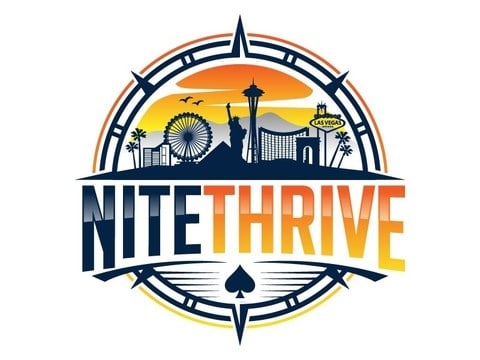Las Vegas is located in the center of the Mojave Desert, so the city is pretty dry most of the year. However, Vegas still sees some rainfall. So that begs the question, how often does it rain in Las Vegas?
Las Vegas gets an average of 26 rainy days every year. The total average annual rainfall for the city is only 4 to 5 inches. Most of the rain comes in short of heavy spurts during monsoon season.
Over the course of the year, Las Vegas doesn’t receive much rain. However, there are a few months where flash floods are a serious issue. In this article, I’ll give a good idea of the weather in Las Vegas every month of the year so you can plan your vacation accordingly.
Also See: What is the meaning of Las Vegas?
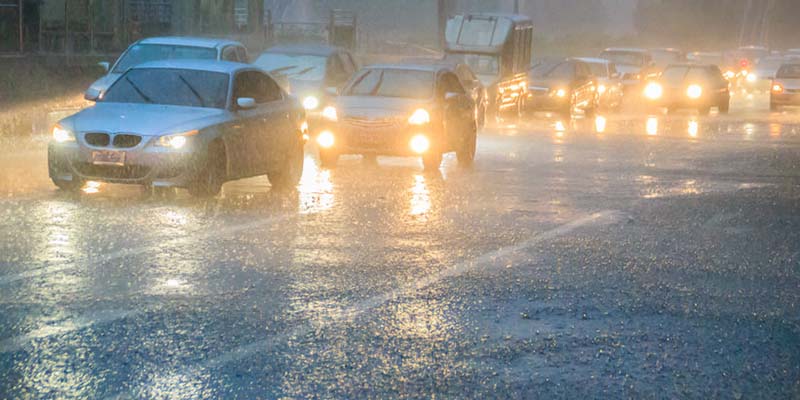
Much Rain does Las Vegas get in a Year?
In the United States, the average annual rainfall is approximately 30 inches per year. Las Vegas Nevada falls way below that benchmark. In fact, Nevada is the state that gets the least amount of annual rainfall.
According to records that date back to the 1930s, Las Vegas averages 4.2 inches (106 millimeters) of rain per year. This makes Las Vegas the driest city in the entire country.
How Many Days get Precipitation in a Year
Those 4.2 inches of annual rain are spread out between 26 days. This puts Las Vegas well below the national average of rainy days per year (the national average is about 100 days).
Rainy days are generally counted as days that get at least 0.01 inches (.25 millimeters) of precipitation. So there are some days where Las Vegas sees small amounts of rain, but they aren’t counted because it’s such a small amount.
Since Las Vegas doesn’t get much precipitation, it’s one of the sunniest cities in the country. The city averages over 300 sunny days a year, which is perfect vacation weather!
Average Las Vegas Rainfall by Month
Las Vegas usually gets less than an inch of rainfall per month. While Vegas doesn’t see much rain overall, there are still months that see more rain than others. The winter months generally receive more precipitation than the summer months.
| Month | Number of Rainy Days | Total Rainfall (inches) |
|---|---|---|
| January | 3.2 | 0.6 |
| February | 4.5 | 0.7 |
| March | 2.8 | 0.5 |
| April | 1.5 | 0.2 |
| May | 1 | 0.1 |
| June | 0.5 | 0.1 |
| July | 2.5 | 0.5 |
| August | 2.5 | 0.5 |
| September | 1.6 | 0.3 |
| October | 1.8 | 0.3 |
| November | 1.6 | 0.4 |
| December | 2.8 | 0.5 |
How many days does it Rain a Month in Vegas?
A common question is, how many days does it rain a month in Las Vegas? Most people are concerned that the rainfall may interrupt their vacation. But that shouldn’t be an issue.
On average, Las Vegas gets 2 to 3 rainy days per month. It is unlikely that you’ll see much rain during your time in Las Vegas. And even if it does rain, it’s not going to rain much. Showers typically don’t last for more than a few minutes at a time.
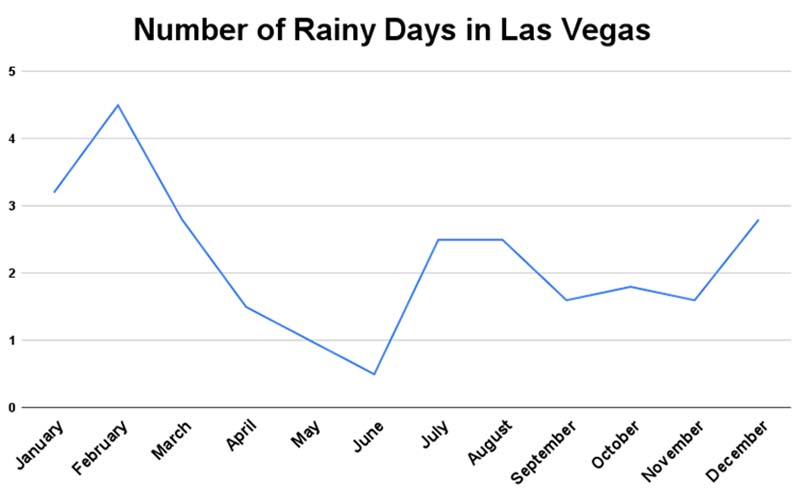
Rainiest Month in Las Vegas
February is the month that usually gets the most rain in Las Vegas. However, it’s still less than an inch of rain spread out between 4 to 5 days, so it shouldn’t affect your vacation plans at all. Just be aware that Las Vegas does get relatively cold in the winter. Snow is always a possibility, however, it’s not likely.
The months with the least rain are May and June since they average 0.1 inches per month. As far as the weather goes, this is the perfect time to visit Las Vegas. The temperatures aren’t too hot and there’s practically no chance of rain.
Although the summer sees the least amount of rain, there is still the potential for extreme flash floods during monsoon season (I’ll talk more about monsoons later in this article).
Also See: Does it Snow in Las Vegas? (Snowfall Totals by Year)
Average Temperature by Month in Las Vegas
If you want to visit Las Vegas when the weather is the best, rain shouldn’t be your main concern. You should be paying more attention to the temperature.
Temperatures in Las Vegas often rise above 110 degrees Fahrenheit at the peak of the summer. When combined with the intense heat from the unrelenting sun, the climate can become uncomfortable to say the least.
You also have to be aware of the temperatures in the winter. Although Las Vegas is located in a desert, it still gets cold. Winter temperatures are relatively mild compared to other parts of the country, but you don’t want to be packing shorts in December.
| Month | Low Temperature (°F) | High Temperature (°F) |
|---|---|---|
| January | 30 | 60 |
| February | 32 | 65 |
| March | 40 | 73 |
| April | 45 | 82 |
| May | 54 | 90 |
| June | 60 | 102 |
| July | 69 | 108 |
| August | 65 | 105 |
| September | 55 | 94 |
| October | 48 | 85 |
| November | 35 | 70 |
| December | 28 | 60 |
As you can see, Vegas isn’t warm year-round. You’re certainly going to want to pack some heavier clothes in the winter months. You won’t need a full winter jacket, but bringing some jeans and a light coat or sweatshirt is something that you will want to consider.
Also, most pools in Las Vegas are closed during the winter months. So unless you’re staying at a hotel with an indoor or heated pool, you won’t need to bring a swimsuit.
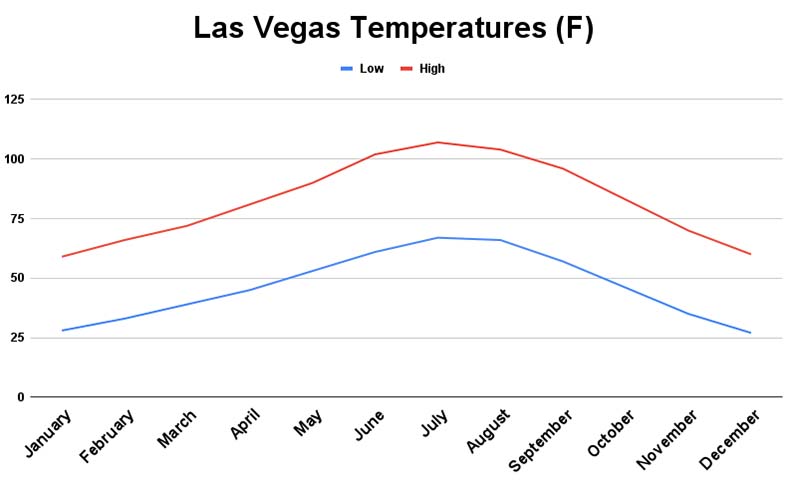
Humidity in Las Vegas by Month
Las Vegas is notoriously dry, so the humidity is very low. While the dry heat makes 100-degree plus temperatures more manageable, it can be uncomfortable for some.
Fortunately, humidity is the highest in the winter when temperatures are more mild. The summer is typically a much drier season which helps to mitigate the extreme heat. Just remember to drink plenty of water.
| Month | Humidity |
|---|---|
| January | 42% |
| February | 30% |
| March | 24% |
| April | 20% |
| May | 18% |
| June | 20% |
| July | 24% |
| August | 25% |
| September | 28% |
| October | 30% |
| November | 32% |
| December | 45% |
The average humidity in Las Vegas is well below the national average. So it isn’t something that you really need to take into consideration when planning a Vegas trip.
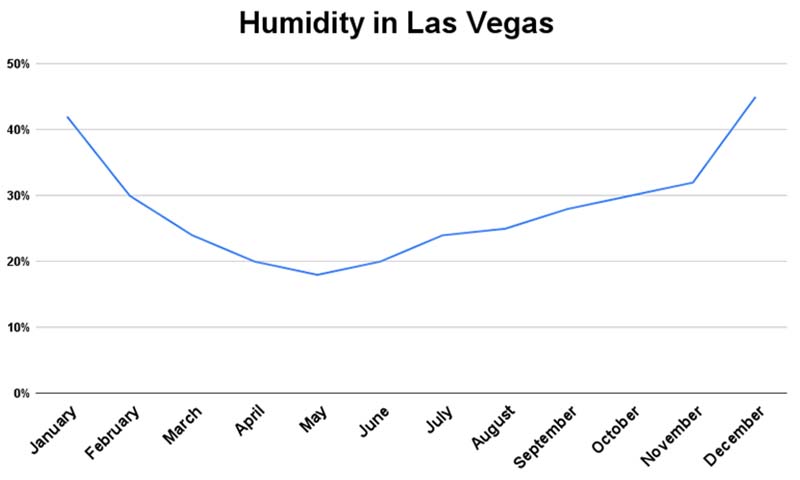
How Many Days Can Las Vegas Go without Rain?
It’s not uncommon for Las Vegas to go months without rain. In 2020, Las Vegas went 240 days without a drop of rain. Now, 2020 was a record-setting year, but a month without any rain is normal for the city.
By definition, deserts receive very little precipitation. However, Las Vegas Valley receives even less rain than the typical desert because it’s a rain shadow desert.
What is a Rain Shadow Desert?
The geography of Las Vegas lends itself to long droughts. Since the city is surrounded by mountains, the clouds in the area must raise in elevation. As they rise, the clouds release their moisture and the rain falls on the far side of the mountain before reaching the city.
By the time the clouds are over Las Vegas, they no longer hold enough water to produce significant rainfall. However, there are times when the clouds do make it over the mountain, which can cause massive flooding.
Floods in Las Vegas (Monsoon Season)
It doesn’t rain often in Las Vegas, but when it rains, it pours. Every few years Las Vegas has flash floods that seemingly come out of nowhere. The city can get up to an inch of rain within a couple of minutes, which quickly causes severe flooding on major roads.
The floods are caused when heavy moisture-filled clouds make it over the mountains and all of the precipitation is released at once. The flooding is amplified when the water flows down the mountain slopes into the city.
When is Monsoon Season?
A monsoon is a relatively rare event in Las Vegas so it isn’t something that you can plan for. You’ll typically only see one big flood every few years. Las Vegas is used to them, so they don’t usually cause too much damage.
Monsoons are most common in July, August, and September but can occur any month of the year. Summertime is generally considered monsoon season.
What to do during Heavy rain in Vegas?
If you find yourself in Las Vegas during heavy rain, you probably have nothing to worry about. There are storm tunnels strategically located throughout the city to help drain water in the event of a flash flood. Flooded areas are typically drained within a matter of minutes.
Aside from not walking into flooded areas, the only time you really need to exercise extreme caution is while driving. You may think your car can handle a couple of inches of water, but the water level rises quickly. Not only will you ruin your vehicle, but you can also be injured or killed in the process.
Flash Foods Come Out of Nowhere
I experienced a flash flood for the first time a week after I moved to Las Vegas. It rarely ever rains in the city, so I didn’t even bother to look at the forecast. When I left my apartment to catch an Uber, I noticed there was some light rainfall.
I didn’t think much of it until my Uber pulled onto a street that was only a block off of the Strip. When the car started making its way down Koval Lane (behind the Flamingo), I suddenly realized there was water up to the car window.
In the end, everything worked out and no one was hurt, but it’s surprising how fast the water levels sneak up on you. It’s never a good idea to drive into a flooded area during a storm. It’s always best to wait it out.
The only other time when heavy rainfall becomes an issue in Las Vegas is during a hike. If your hike starts to get rainy, it’s a good idea to seek higher ground and wait for the rain to stop. Water flowing downhill through narrow canyons can become dangerous in a hurry.
Does the Las Vegas Strip ever Flood?
Although it has happened in the past, I haven’t seen the Las Vegas Strip flood in many years. The storm drains do a fantastic job of removing excess rainwater.
The only part of the Strip that I have seen flood is the LINQ parking garage. It seems like a lot of the water from the Strip is funneled through that area before it reaches the storm drains. Whenever there is significant rain in Las Vegas, the LINQ garage always seems to be closed for a couple of hours.
If you’re in one of the hotels on the Strip, you have nothing to worry about. All the hotels have rain drainage systems and are elevated off of the street. You probably won’t even notice that it’s even raining.
Does it Ever Rain all Day in Las Vegas?
It never rains in Las Vegas for a full day. As we have already discussed, a rainy day in Las Vegas is a rare occurrence. There are only a handful of days that see a measurable amount of rainfall each year. And if it does rain, it typically stops within a matter of minutes.
There is no need to concern yourself with the weather forecast when planning a Vegas trip unless you’re hiking. Even small amounts of rain can become deadly if you’re hiking in the wrong place at the wrong time.
Things to do When in Rains in Vegas
There are plenty of things to do in Las Vegas, even when it’s raining. Here are a few activities you can do in Las Vegas, even during bad weather.
- Gambling at a casino
- Seeing one of the many shows on the Strip
- Going to a comedy club
- Dining at a nice restaurant
- Eating at a hotel buffet
- Attending a sporting event
- Going to a bar or nightclub
- Shopping
- Spending the day at the spa
- Visiting a museum
This isn’t a complete list since many of the major tourist attractions are indoors. There are hundreds of things you can do in Las Vegas when it rains.
Rainy days in Las Vegas don’t usually last for more than a couple of minutes, so an easy thing to do when it rains is simply to grab lunch. By the time you’re finished eating, the rain will probably already have stopped.
Conclusion
Rain shouldn’t be a factor in determining when you visit Las Vegas. The weather is pretty good year-round since there are hardly any days with rain. Las Vegas is sunny over 300 days a year and can go weeks without rain.
If you are taking weather into account when planning your Las Vegas trip, it’s a much better idea to be aware of the temperature. The winter climate is usually much colder than expected for first-time visitors.
